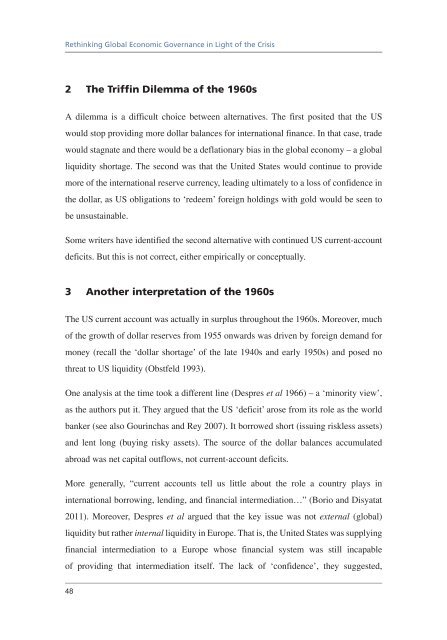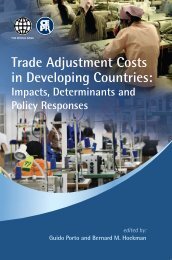Download PDF - Vox
Download PDF - Vox
Download PDF - Vox
- No tags were found...
You also want an ePaper? Increase the reach of your titles
YUMPU automatically turns print PDFs into web optimized ePapers that Google loves.
Rethinking Global Economic Governance in Light of the Crisis2 The Triffin Dilemma of the 1960sA dilemma is a difficult choice between alternatives. The first posited that the USwould stop providing more dollar balances for international finance. In that case, tradewould stagnate and there would be a deflationary bias in the global economy – a globalliquidity shortage. The second was that the United States would continue to providemore of the international reserve currency, leading ultimately to a loss of confidence inthe dollar, as US obligations to ‘redeem’ foreign holdings with gold would be seen tobe unsustainable.Some writers have identified the second alternative with continued US current-accountdeficits. But this is not correct, either empirically or conceptually.3 Another interpretation of the 1960sThe US current account was actually in surplus throughout the 1960s. Moreover, muchof the growth of dollar reserves from 1955 onwards was driven by foreign demand formoney (recall the ‘dollar shortage’ of the late 1940s and early 1950s) and posed nothreat to US liquidity (Obstfeld 1993).One analysis at the time took a different line (Despres et al 1966) – a ‘minority view’,as the authors put it. They argued that the US ‘deficit’ arose from its role as the worldbanker (see also Gourinchas and Rey 2007). It borrowed short (issuing riskless assets)and lent long (buying risky assets). The source of the dollar balances accumulatedabroad was net capital outflows, not current-account deficits.More generally, “current accounts tell us little about the role a country plays ininternational borrowing, lending, and financial intermediation…” (Borio and Disyatat2011). Moreover, Despres et al argued that the key issue was not external (global)liquidity but rather internal liquidity in Europe. That is, the United States was supplyingfinancial intermediation to a Europe whose financial system was still incapableof providing that intermediation itself. The lack of ‘confidence’, they suggested,48














